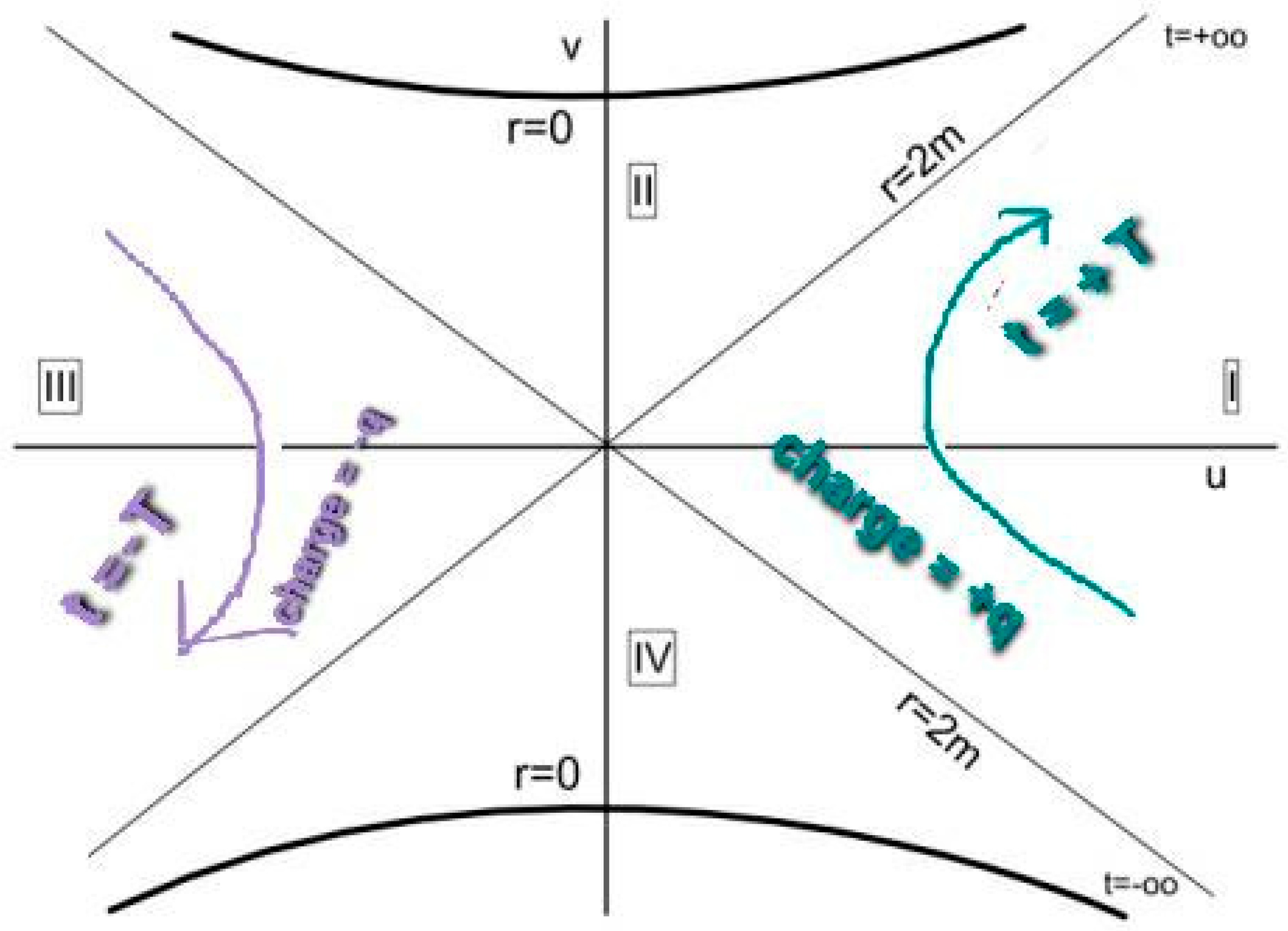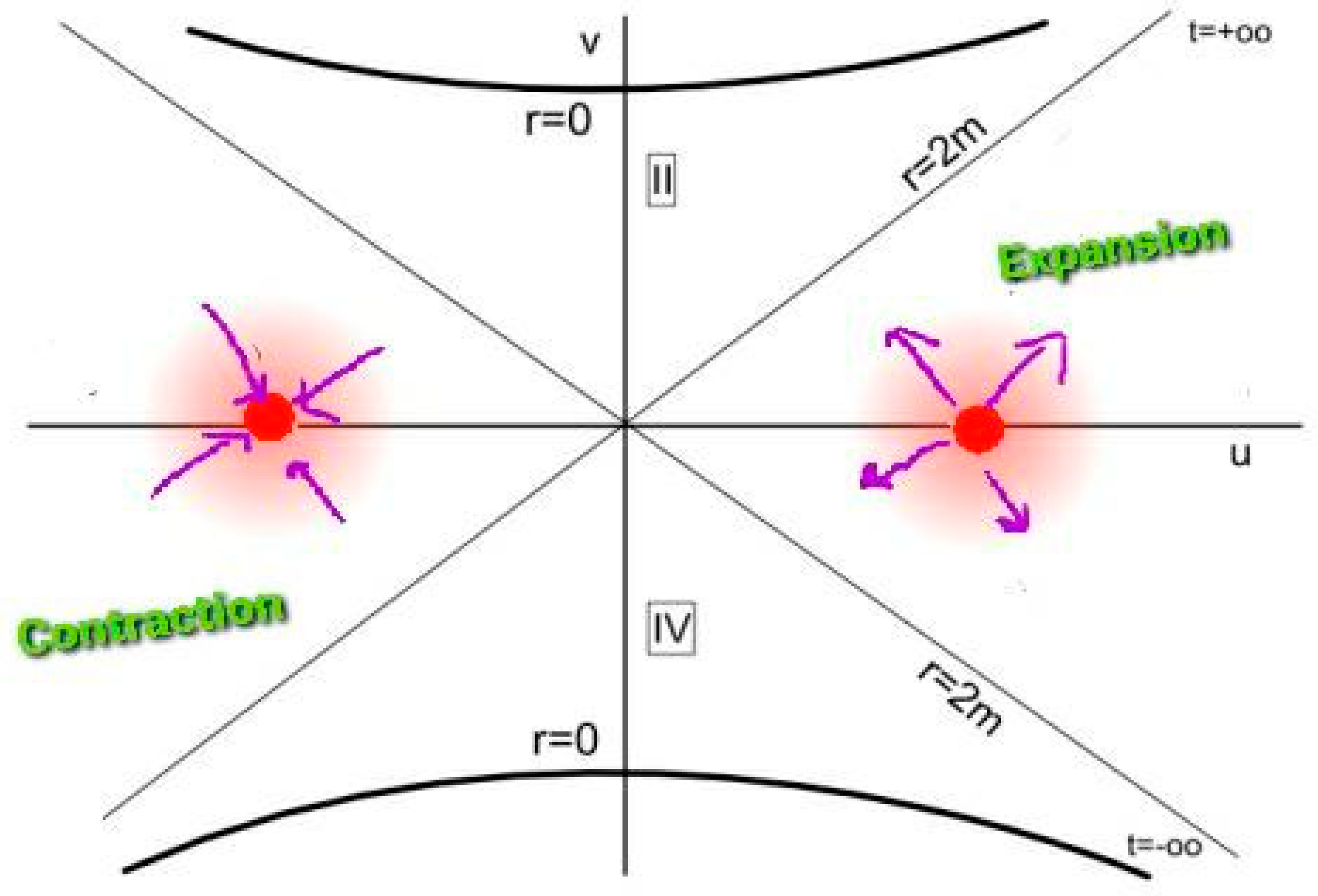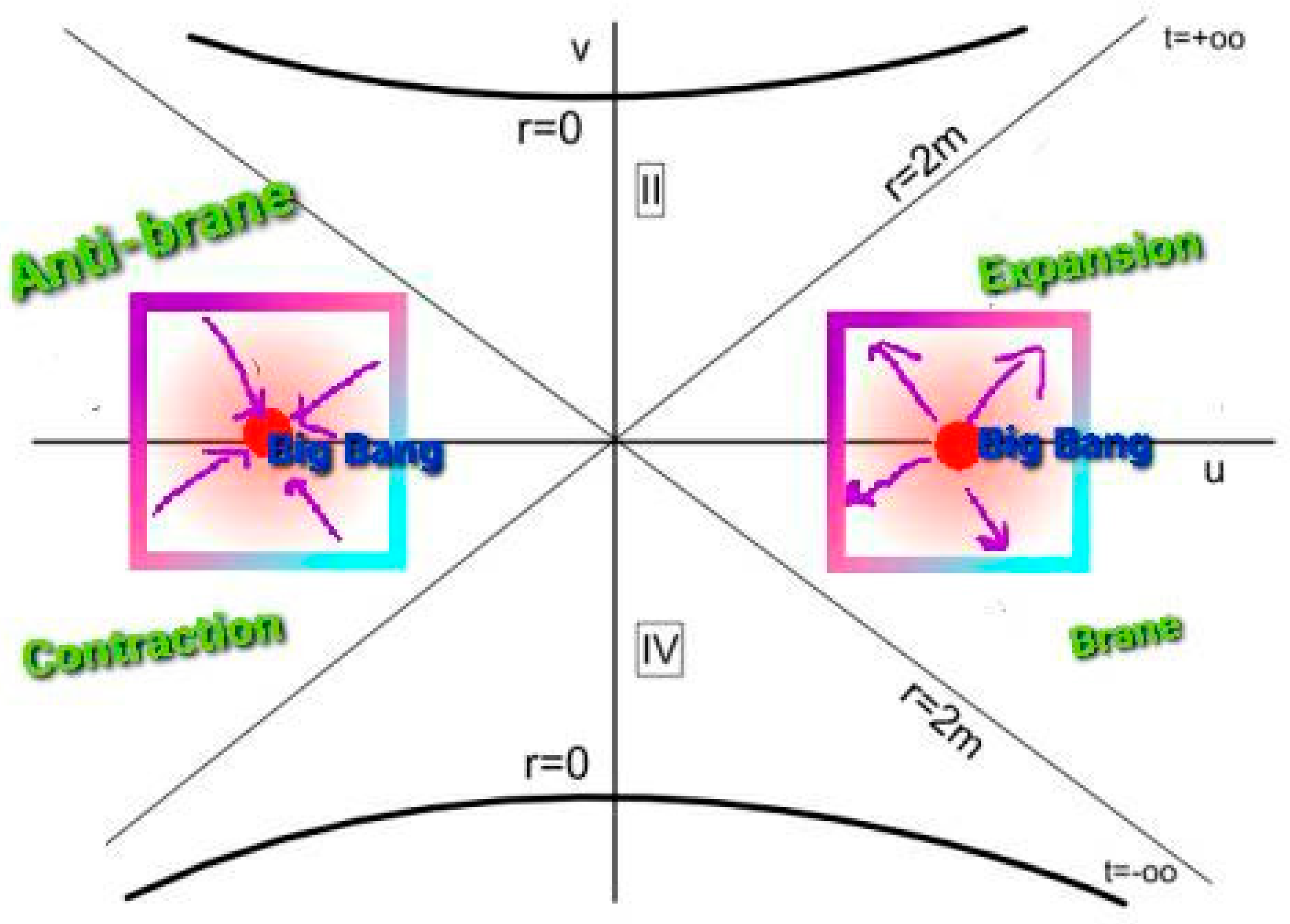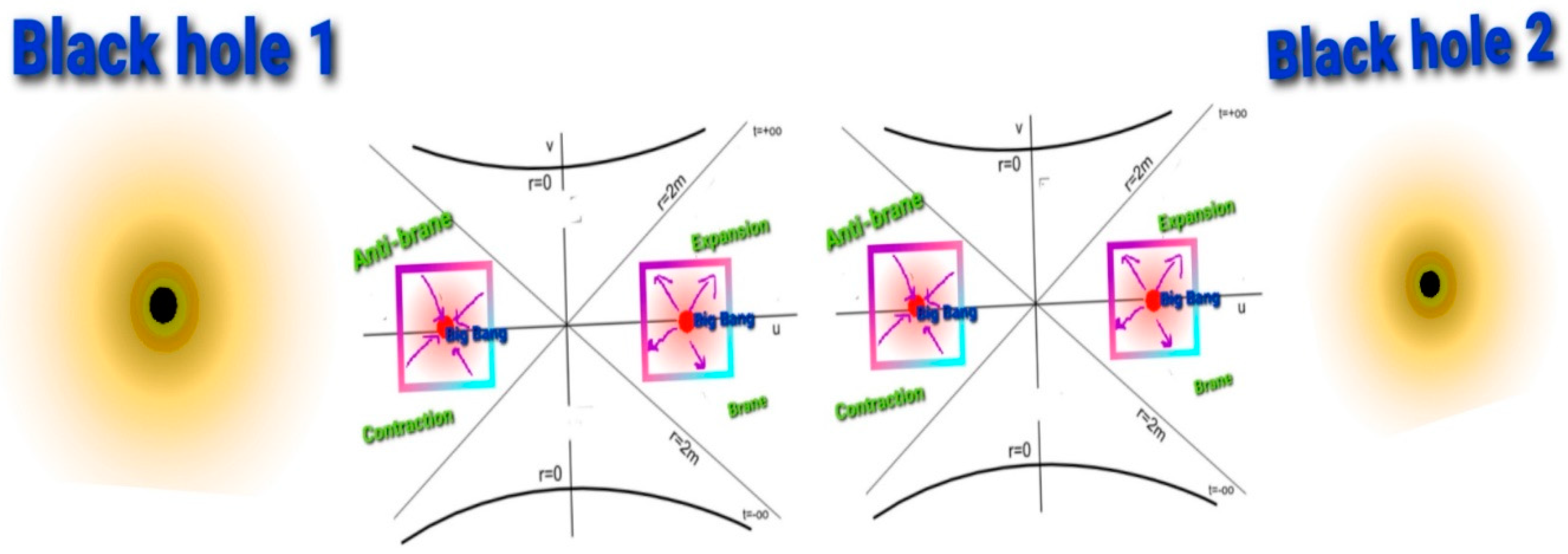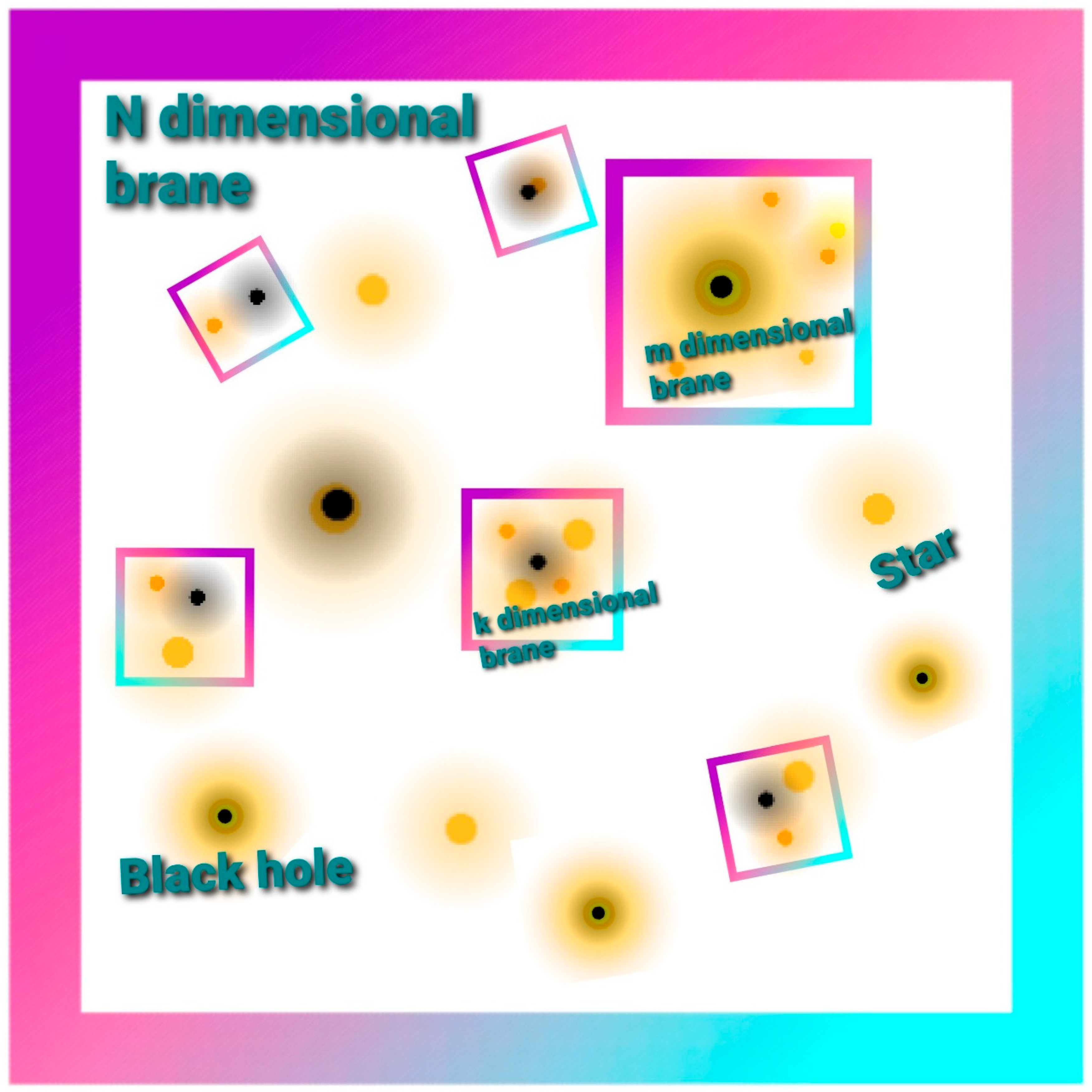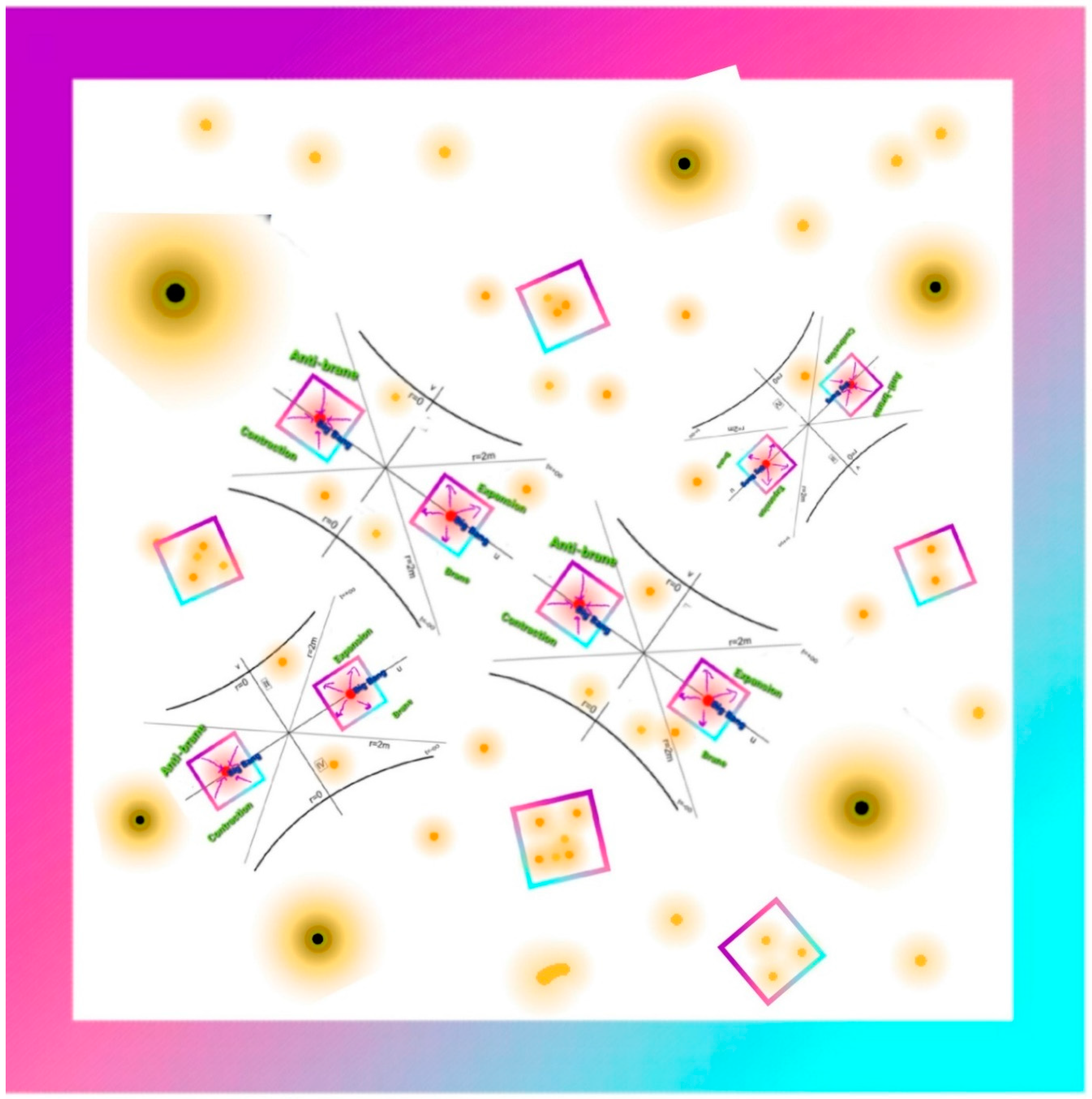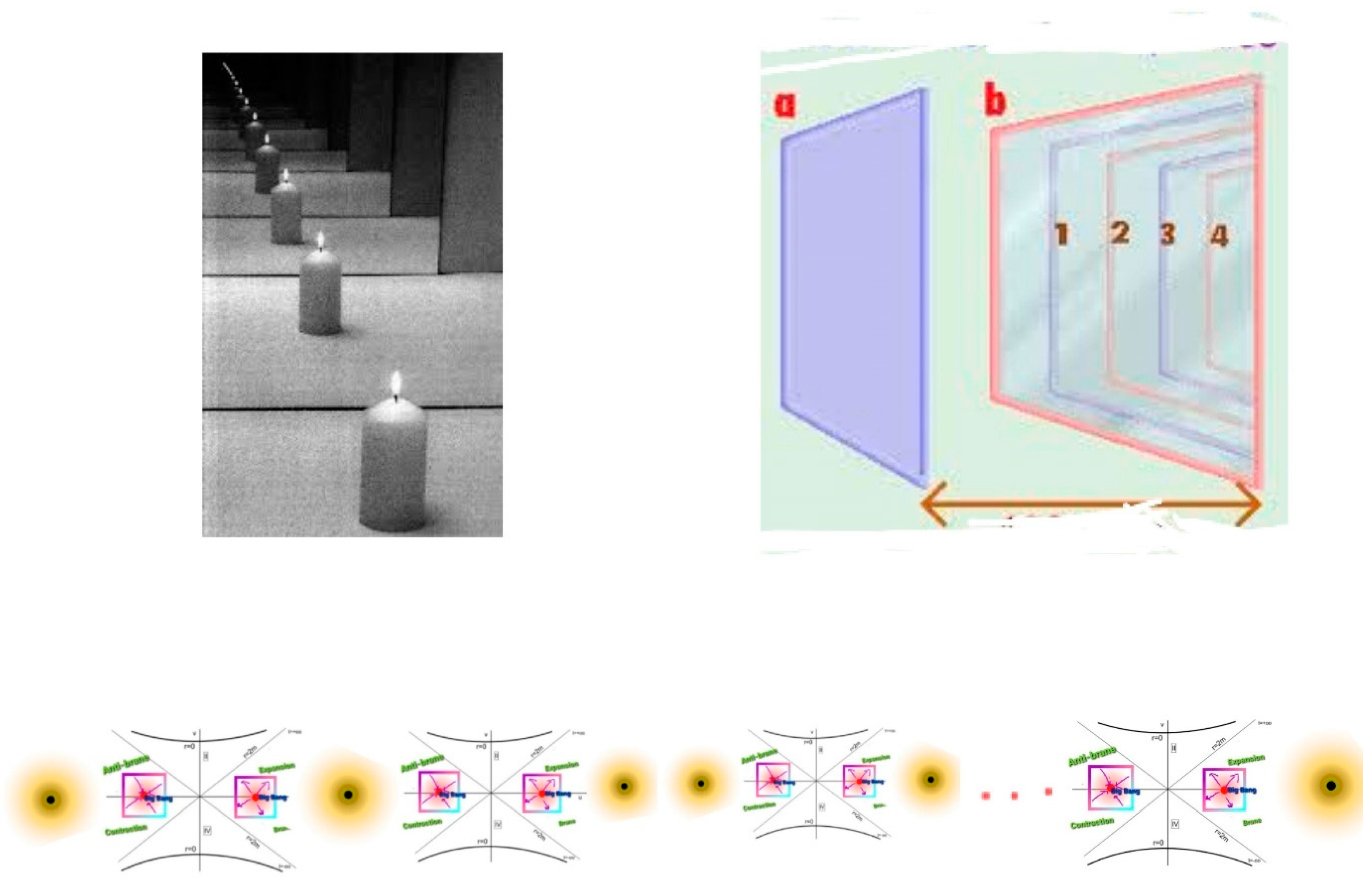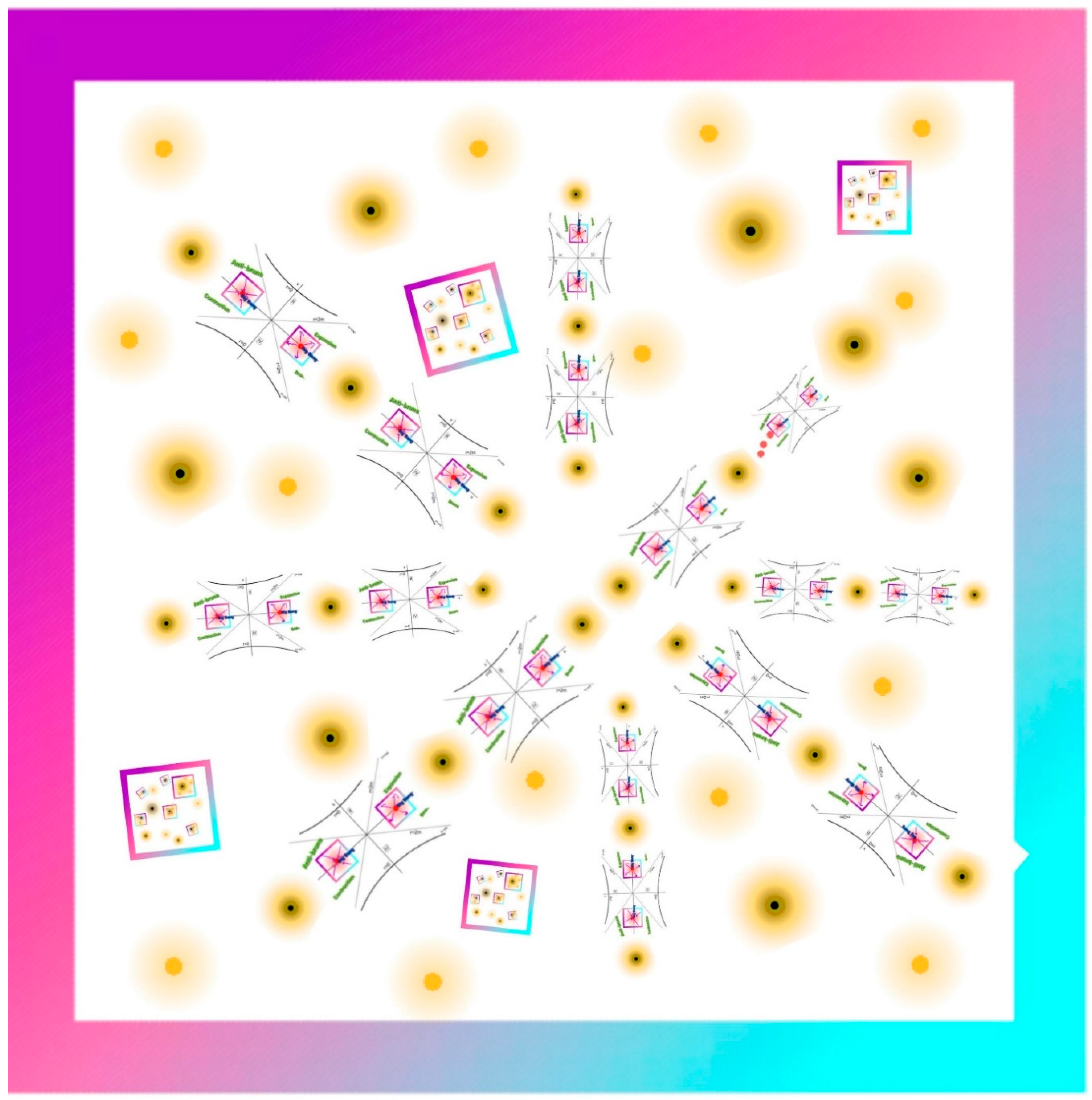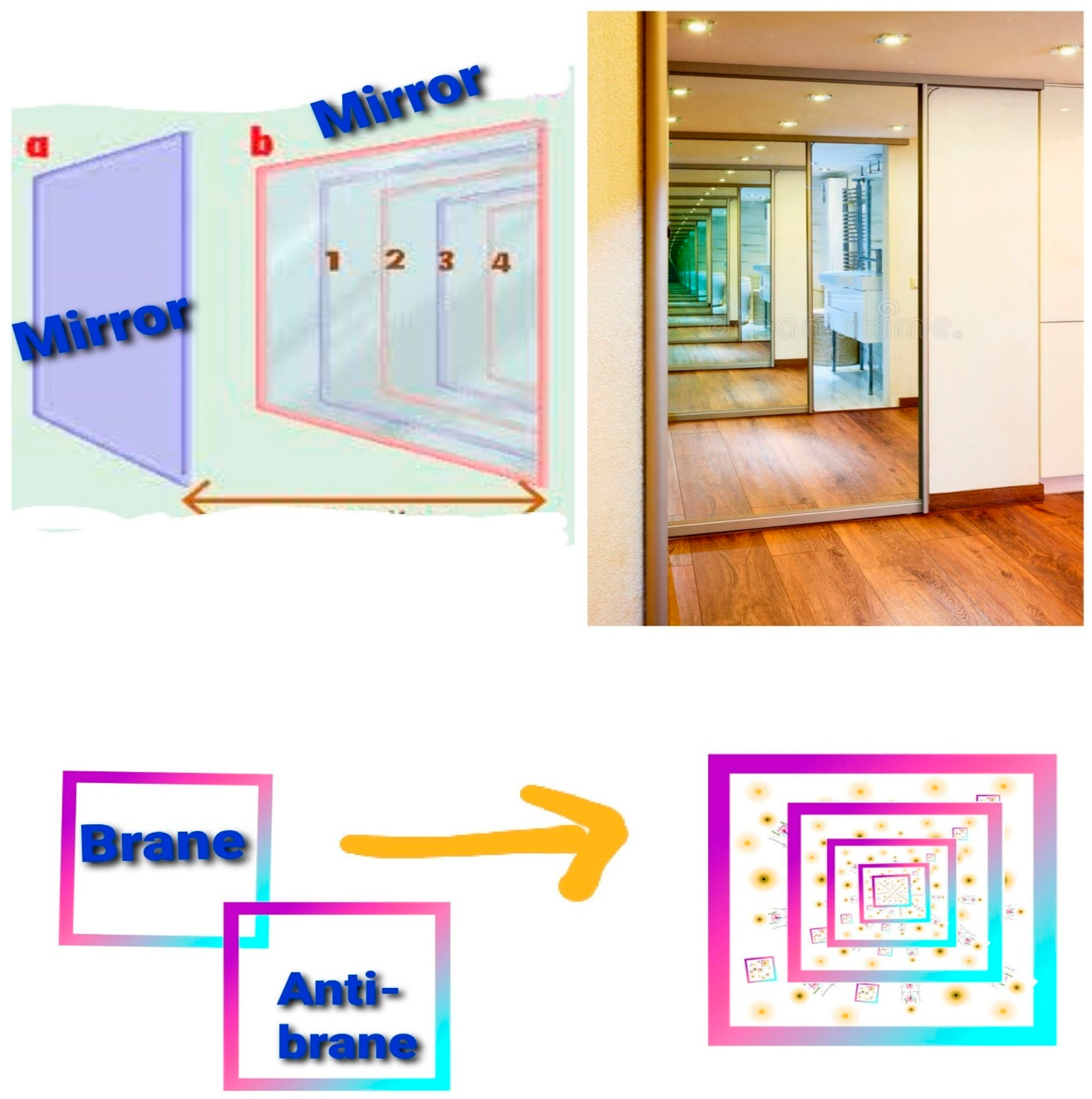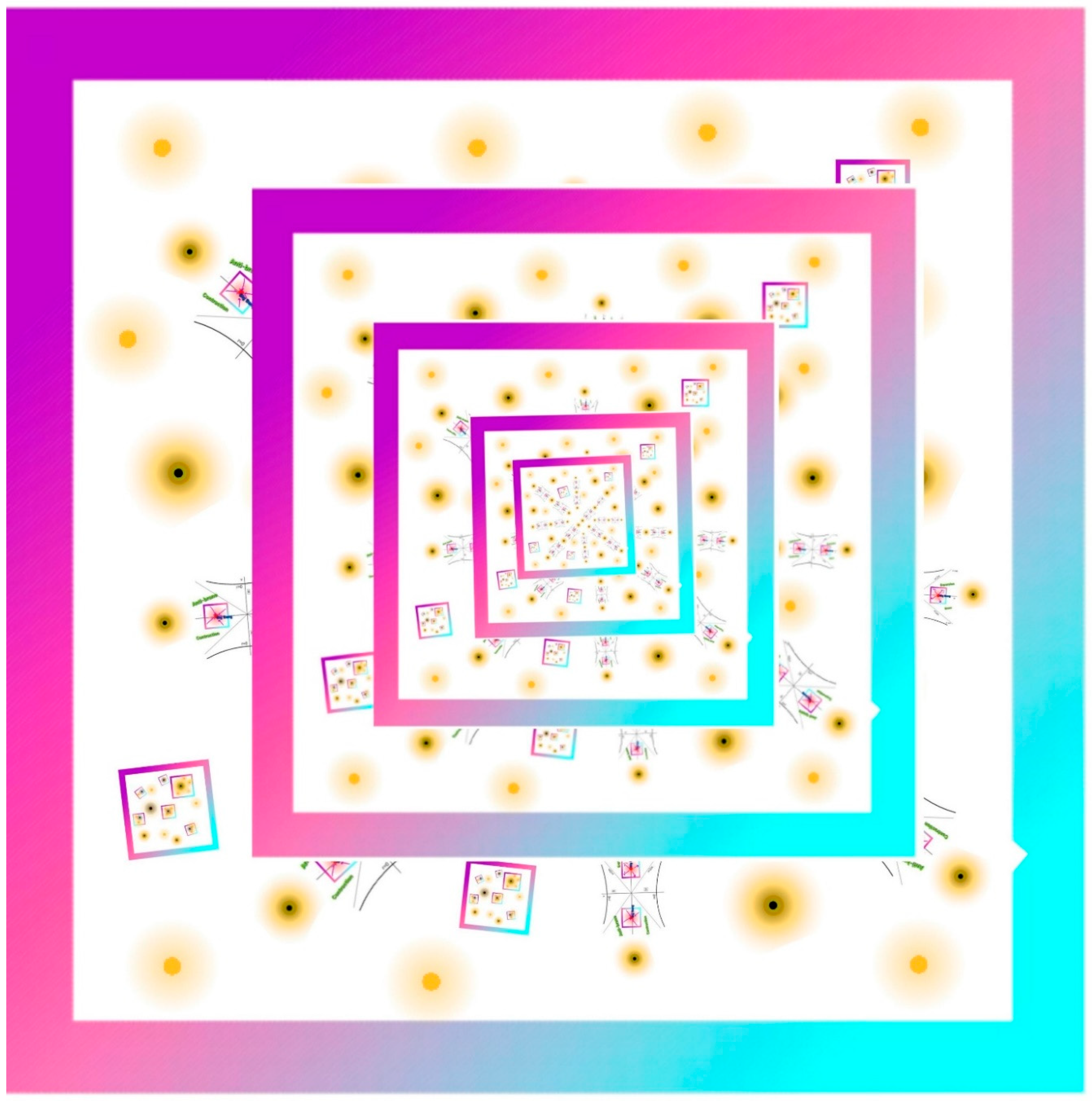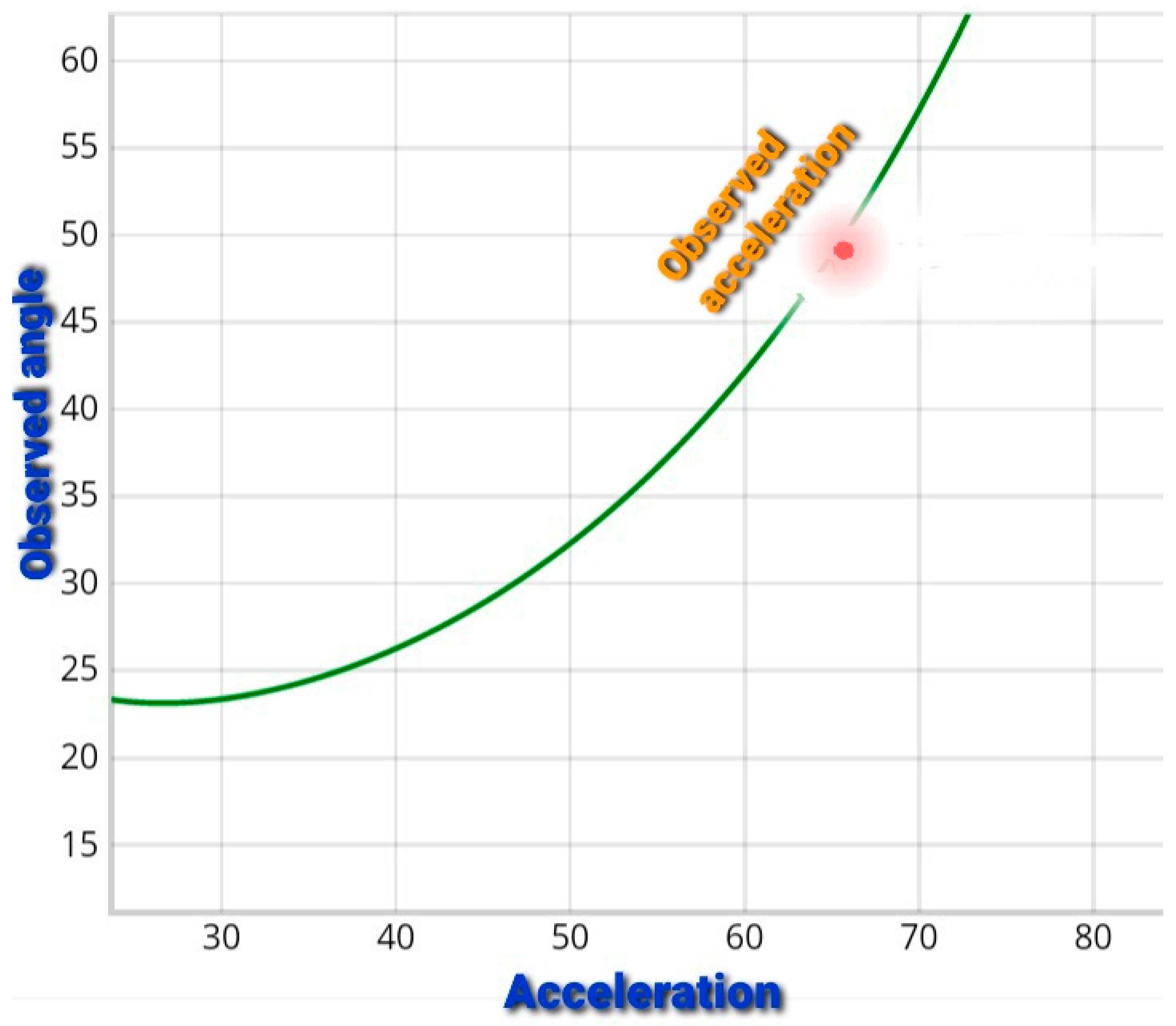1. Introduction
Recently, some authors have discussed the hypothesis that the state of the universe does not spontaneously violate charge, parity and time reversal (CPT). Rather, after the big bang, the universe is the CPT image of the universe prior to the big bang, both quantum mechanically and classically [
1]. This consideration has shown that the universe before the bang and the universe after it may be viewed as a universe/anti-universe pair, emerging directly into the hot, radiation era that we observe in our past. This idea leads to a remarkably economical explanation of cosmological dark matter [
2]. Although this proposal was put forward a few years ago, some parallel ideas have been published as far back as 1973, e.g., one paper considered CPT conservation in the oscillation of universe [
3]. Based on this idea is an oscillating model of the Universe in which the direction of time flow reverses between alternate cycles [
4]. Thus, creation of universes on two sides of the time arrow can occur more than once, or maybe, more than one pair of universes appear, and they act like a mirror. For this reason, this idea could be extended so as describe the basis of a mirror world [
5,
6].
On the other hand, this idea has been tested by some investigators. Licata et al. [
7] re-examined the CPT universe proposal from the point of view of archaic cosmology, based on de Sitter projective relativity and an event-based reading of quantum mechanics. In this scenario, the big bang is caused by the instability of the original (pre) vacuum with respect to the nucleation of micro-events (creation of particles). In other article, Volovik [
8] extended the CPT universe idea is to the temperature of the system. This extension suggests that if such analytic continuation is valid, then it is possible that the initial stage of the evolution of the Universe on our side of the Big Bang was characterized by negative temperature.
In this article, we suppose that the Big Bang of our universe may occur near a black hole binary system in a higher dimensional world. This binary system acts like a mirror, and many images of the Big Bang and its evolution appear. In this model, all evolutions before the Big Bang could be seen after it in the reverse direction within a mirror. Applications to higher-dimensional space-times are investigated. The outline of the paper is as follows: In
Section 2, the emergence of CPT universes; mirror worlds and Big Bangs in the background of a binary system have been considered. In
Section 3, the properties of many small universes and worlds in two higher dimensional worlds have been considered. In
Section 4, the origin of dark energy in this system is considered, and finally, in the last section our conclusion is presented.
2. CPT Universes and Binary Black Hole Systems
Around a black hole or any other gravitational object, the space-time is curved. In this space-time, there are two regions. These regions have opposite properties, e.g., quantum numbers like charge, color and flavor in each region have opposite sign with respect to their respective quantum numbers in the other region [
9]. On the other hand, the direction of motion of an observer in one region is in the opposite direction of motion of an observer in the other region. If an electron moves in the positive direction of time and space in one region, a positron (with opposite charge) moves in the opposite or negative direction of time and space in the other region. Thus one region is the mirror image of the other region (See
Figure 1).
Now, suppose that a Big Bang occurs in one region in a curved space-time and a universe is born and expands. In the other region, a universe contracts and moves towards its Big Bang (See
Figure 2).
To clear this point, suppose that our universes are places on a brane. Branes act like pages. In one region, a page contracts at one point initially. This stage could be known as the Big Bang. Then, this page expands and a universe is born. In the other region, an expanded page with opposite charges and quantum numbers is contracting, and moving towards a point (See
Figure 3).
Now, the question that arises is how this curved space-time emerges. The best candidate for the cause of this curved space-time is a black hole. A black hole has a large mass which has contracted to a small region, and emits many gravitons and gravitational waves. These objects could be formed within any brane with any dimension. On the other hand, each brane contains many smaller branes with lower dimensions. When a brane is close to a black hole within a higher dimensional brane, the black hole curves the space-time, and an image with opposite charges and quantum numbers in the other region appears. This image acts oppositely to the brane and is like an anti-brane. When a brane is expanding, its image or anti-brane is contracting (See
Figure 4).
Instead of one black holes, if two black holes form a binary system, then each of them has itself a curved space-time [
9,
10,
11]. Each of the curved space-times produces images of any closed object, e.g., if a brane is closes to a binary system, at least three, four or more images are formed (See
Figure 5).
Thus, a binary system acts like two mirrors, and many images of a universe or a brane with opposite charges are produced. However, some universes are expanding and their images are contracting. Summing over the branes and anti-branes, or universes and antiuniverses yields the CPT symmetry.
3. CPT Universes and Branes in Higher Dimensional Branes
Each brane may be likened to an N dimensional page. This page may contain many k dimensional pages or branes where k < N. Within this N dimensional brane, there are many higher dimensional black holes. Two of these could come close enough to each other to form a binary system, and several such systems could form. These systems produce a complicated curved space time which form many images from smaller branes and objects. Our universe may be located on one of these smaller branes and thus it may have many images with opposite quantum numbers (See
Figure 6). In fact, each N dimensional brane contains many binary systems which act like the mirrors for smaller branes, and produce images which move in opposite directions. There are also mirrors such that when a smaller brane is expanding, its image may be contracting (See
Figure 7). In addition to the images of small branes, a binary black hole system may produce images of itself also: each black hole in this system may produce an image of the other black hole, and again the image of one of these black holes may again produce a second image of the other black hole. This production of images continues many times over. Each image of a binary system itself has a complicated curved space time, and produces images of small branes (See
Figure 8). Thus, each binary black hole system is similar to a mirror which not only produces many images of objects but also produces many images of itself (See
Figure 9).
Each N dimensional brane contains many binary systems and such a system produces many images of itself, and each image produces many images of branes. These images act oppositely to each other, i.e., when one image is expanding, there is another image which is contracting, and its quantum numbers are opposite. Summing over all images and branes yields the CPT invariant system (See
Figure 10). If an N dimensional anti-brane is placed in front of the brane, these branes act like two mirrors which are facing each other and produce many images. Binary systems and small branes or their images in one brane act oppositely with respect to the systems and branes in the other brane (See
Figure 11). Thus, exactly similar to the state that two mirrors are close to each other, two branes close to each other produce many images (See
Figure 12).
4. Dark energy, Dark Matter and Mirror Cosmic Systems
It is known that when two mirrors face each other, depending on the angle between them, a number of images are produced. In fact, the number of images could be obtained from the formula:
Now, the question arises whether dark energy could be the result of images of observed matter on our brane. We know that only about 5% of the total matter in the universe could be “seen”, and the remaining matter is dark. Also, we know that approximately 68% of the total matter is dark energy. Thus, dark energy is 13.6 times the observed matter. If dark energy is the image of observed matter, we can estimate the angle between the cosmic mirrors, e.g., the angle between black holes in a binary system. We obtain:
However, this equation is related to objects in flat space-time. Cosmic mirrors produce curved space-time and thus, the angle changes to:
In this equation,
acceleration is the relative acceleration of the cosmic mirrors. The present observed acceleration rate of the universe is 67 [
12,
13,
14]. For this acceleration, using equation (2), we can estimate the angle between the cosmic mirrors, which works out to be
(See
Figure 13).
However, it is likely that the angle and acceleration change with time.
5. Conclusions
Boyle, Finn and Turok put forward the hypothesis that the universe did not violate CPT symmetry, hence leading to the creation of a pair of universes, one before the big bang, and the other after. The one universe is the mirror image of the other, both classically and quantum mechanically. The universe before the bang and the universe after may be viewed as a universe/anti-universe pair. In the oscillating model of the universe, the direction of time flow reverses between alternate cycles. This may be interpreted as the creation of universes occurring more than once, or more than one pair of universes appearing, and acting as mirrors, cf., the mirror world. Mirror matter has the same particle physics as our world, and it interacts with our universe only via gravity. Mirror baryons have been proposed as a candidate for dark matter, and its density can exceed the density of ordinary matter by up to five times [
5]. At present, mirror matter appears to be the only possibility of explaining the coincidence of the densities of dark and ordinary matter. The predictions from the mirror universes with regard to black hole merger rates is in keeping with the observational results from LIGO [
10,
11,
14]. Future high precision data concerning the large scale structure, CMB anisotropy, structure of the galaxy halos, gravitational microlensing, oscillation of neutrinos or other neutral particles into their mirror partners, etc, offers the hope of detecting such dark mirror matter in the foreseeable future [
6].
Since the idea of mirror worlds has some very interesting consequences, in this work, we extend this idea of a mirror pair of universes to that of two black holes in a binary system which act like two mirrors, and produce many images of themselves, as well as a brane/anti-brane. These images have opposite quantum numbers and charges, and expand or contract oppositely with respect to each other. For example, within the back ground of a binary system, when a brane expands, the anti-brane contracts. Summing over all images and branes yields the CPT invariant system. Also, dark energy could be a collection of images of the observed matter. It is interesting to note that Das et al. [
15] assumed the existence of a superstring-inspired shadow world, in contrast to the mirror world. This shadow world has a chain of symmetry groups which is different to the symmetry group of the ordinary world. By doing this, they have explained, inter alia, the origin of ordinary matter, dark matter and dark energy.
Despite all the research that is taking place, we still do not know what dark energy is. We have offered the possibility that it could be the collection of mirror images of observed matter. These mirror images have some of the desired properties of dark energy, viz., they can interact with us only via gravity, and not electromagnetic radiation. We are investigating further insights into these ideas, and hope to report on them elsewhere
Funding
This research received no external funding.
Data Availability Statement
Not applicable.
Acknowledgments
Not applicable.
Conflicts of Interest
The author declares no conflict of interest.
References
- Boyle, L.; Finn, K.; Turok, N. CPT-Symmetric Universe. Phys. Rev. Lett., 2018, 121, 251301. [Google Scholar] [CrossRef] [PubMed]
- Boyle, L.; Finn, K.; Turok, N. The Big Bang, CPT, and neutrino dark matter. Ann. Phys. 2022, 438, 168767. [Google Scholar] [CrossRef]
- Albrow, M. Conservation in the Oscillating Model of the Universe. Nat. Phys. Sci. 1973, 241, 56–57. [Google Scholar] [CrossRef]
- Davies, P.C.W. Closed Time as an Explanation of the Black Body Background Radiation. Nat. Phys. Sci. 1972, 240, 3–5. [Google Scholar] [CrossRef]
- Beradze, R.; Gogberashvili, M. Gravitational Waves from Mirror. World. Phys. 2019, 1, 6775. [Google Scholar] [CrossRef]
- Berezhiani, Z. Mirror World and its Cosmological Consequences. Int. J. Mod. Phys. A 2004, 19, 3775–3806. [Google Scholar] [CrossRef]
- Licata, I.; et al. CPT symmetry in cosmology and the Archaic Universe. Phys. Scr. 2020, 95, 075004. [Google Scholar] [CrossRef]
- Volovik, G.E. Comment to the CPT-Symmetric Universe: Two Possible Extensions. Jetp Lett. 2019, 109, 682–683. [Google Scholar] [CrossRef]
- Fuentes-Schuller, I.; Mann, R. Alice Falls into a Black Hole: Entanglement in Noninertial Frames. Phys. Rev. Lett. 2005, 95, 120404. [Google Scholar] [CrossRef] [PubMed]
- Abbott, B.P.; et al. (LIGO Scientific Collaboration and Virgo Collaboration). GW151226: Observation of Gravitational Waves from a 22-Solar-Mass Binary Black Hole Coalescence. Phys. Rev. Lett. 2016, 116, 241103. [Google Scholar] [CrossRef] [PubMed]
- Abbott, P.B.; et al. (LIGO Scientific and Virgo Collaboration). Observation of Gravitational Waves from a Binary Black Hole Merger. Phys. Rev. Lett. 2017, 118, 221101, Erratum Phys. Rev. Lett.2018, 121, 129901. [Google Scholar] [CrossRef]
- Peebles, P. J. E.; Ratra, B. The cosmological constant and dark energy. Rev. Mod. Phys. 2003, 75, 559–606. [Google Scholar] [CrossRef]
- Frieman, J.A.; Turner, M.S.; Huterer, D. Dark Energy and the Accelerating Universe. Ann. Rev. Astron. Astrophys. 2008, 46, 385–432. [Google Scholar] [CrossRef]
- Riess, A.G.; et al. Observational Evidence from Supernovae for an Accelerating Universe and a Cosmological Constant. Astron. J. 1998, 116, 1009–1038. [Google Scholar] [CrossRef]
- Das, C.R.; et al. Mirror world and superstring-inspired hidden sector of the Universe, dark matter and dark energy. Phys. Rev. D 2011, 84, 063510. [Google Scholar] [CrossRef]
|
Disclaimer/Publisher’s Note: The statements, opinions and data contained in all publications are solely those of the individual author(s) and contributor(s) and not of MDPI and/or the editor(s). MDPI and/or the editor(s) disclaim responsibility for any injury to people or property resulting from any ideas, methods, instructions or products referred to in the content. |
© 2023 by the author. Licensee MDPI, Basel, Switzerland. This article is an open access article distributed under the terms and conditions of the Creative Commons Attribution (CC BY) license (https://creativecommons.org/licenses/by/4.0/).
